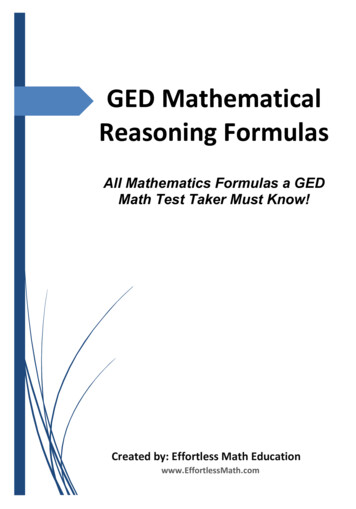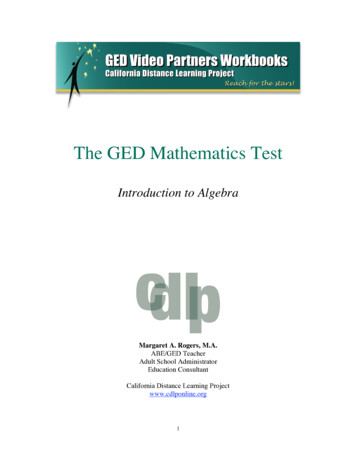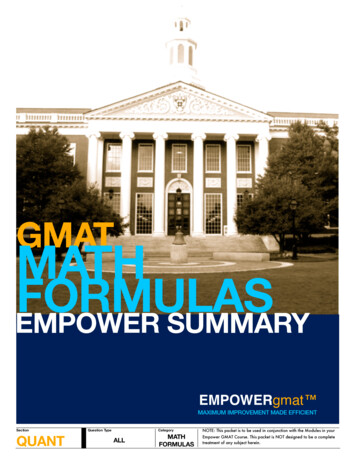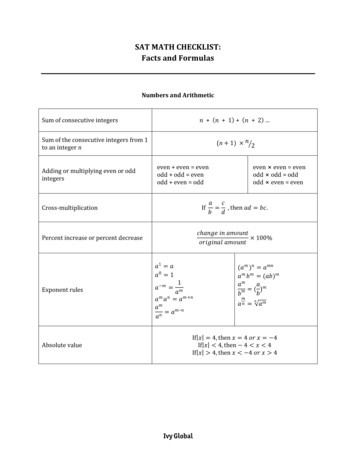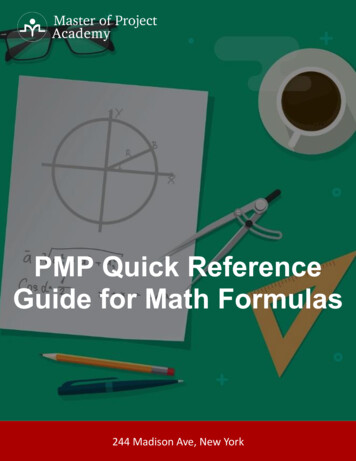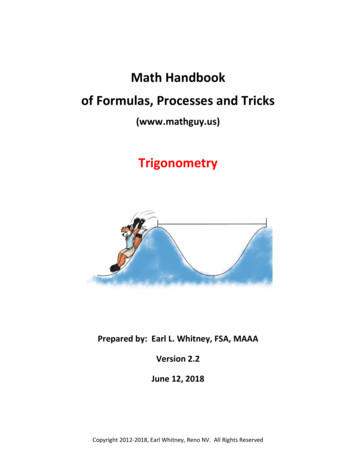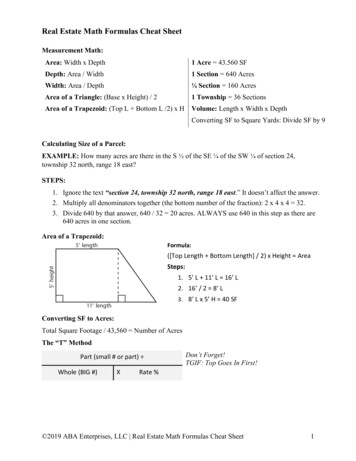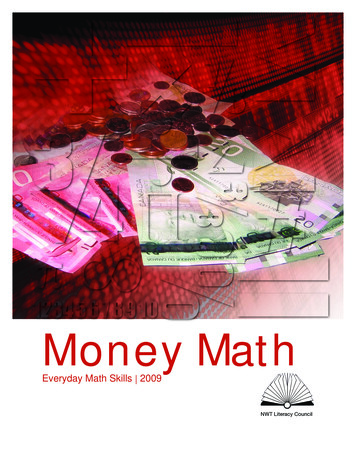
Transcription
Math Smart643The GED Math FormulasThe GED math test gives you a page of math formulas thatyou can use on the test, but just seeing the formulas doesn’tdo you any good. The important thing is understanding what theymean. Here’s a breakdown of the GED math formulas. Remember,they’re in the GED test booklet to help you out, so you don’t needto memorize them. You just need to understand what they mean.AreaAREA of a:squareArea side2rectangleArea length widthArea is just the amount of space on a surface. That’s all. Fora square or rectangle, it’s just the length of two adjoining sidesmultiplied by each other. So, if you’ve got a 6 4 room, you need6 4 square feet of carpet, or 24 square feet. 2008 by The GED Academy. You are licensed one copy of this document for personal use only. Any otherreproduction or redistribution is prohibited. All rights reserved. w w w . p a s s G E D . c o m
644Math SmartAREA of a:parallelogramArea base heightA parallelogram is just a four-sided figure where the oppositesides are parallel, or slanting the same way. It’s like a rectangle, butinstead of measuring the length of the sides, you measure one flatside, and then the height, straight up. Multiply them together to getarea. The reason this works is because a parallelogram is the samearea as a rectangle of the same height and width. You could cut offone side, and move it to the other side, to make a rectangle.AREA of a:triangleArea base height 2008 by The GED Academy. You are licensed one copy of this document for personal use only. Any otherreproduction or redistribution is prohibited. All rights reserved. w w w . p a s s G E D . c o m
Math Smart645A triangle is half a parallelogram, so you get the area bymultiplying ½ times base (bottom) times height (straight up).AREA of a:trapezoidArea (base1 base2) heightA trapezoid is a 4-sided figure with two parallel sides. Thesides that run parallel to each other are different lengths. Add themtogether and divide by two to get an average, and then multiply bythe height (straight up). 2008 by The GED Academy. You are licensed one copy of this document for personal use only. Any otherreproduction or redistribution is prohibited. All rights reserved. w w w . p a s s G E D . c o m
646Math SmartAREA of a:circleArea π radius2;π is approximately equal to 3.14A circle is a little different. You need to use “pi.” That’s thatfunny-looking figure. Just think of it as 3.14. To get the area (flatsurface) of a circle, multiply 3.14 times the radius squared. Theradius is the distance from the center of the circle to the edge, andsquared just means multiply it by itself. So, if the circle is 4 inchesacross, the radius is 2 inches, and the area is 3.14 2 2, or justover 12. (Approximating can be very helpful!)What i s pi?Pi is the number that you get when you divide thecircumference of a circle (the distance around theoutside) by its diameter (the distance across the center).Pi is the same for all circles, so it can be handy in doingmath with circles. The decimals of the number pi go onand on forever, without repeating, making pi an irrationalnumber. 3.14 is a very rough idea of the number pi. Here’sa bit more of the number: 3.14159265358979323846. 2008 by The GED Academy. You are licensed one copy of this document for personal use only. Any otherreproduction or redistribution is prohibited. All rights reserved. w w w . p a s s G E D . c o m
Math Smart647Perimeter and CircumferencePERIMETER of a:squarePerimeter 4 siderectanglePerimeter 2 length 2 widthtrianglePerimeter side1 side2 side3Perimeter is just how long the outside lines of a shape are so, how much fence you’d need to put around a pasture, or howmuch framing you’d need to frame a picture. On the square,rectangle, or triangle, or any figure with straight sides, it’s just thelength of all the sides added together. Easy. 2008 by The GED Academy. You are licensed one copy of this document for personal use only. Any otherreproduction or redistribution is prohibited. All rights reserved. w w w . p a s s G E D . c o m
648Math SmartCIRCUMFERENCE of a:circleCircumference π diameter;π is approximately equal to 3.14On a circle, you’ve got to use pi again so it’s approximately3.14 diameter—that’s the length across the center of a circle. Fora 5-inch across circle, the circumference is about 3.14 5, or justover 15 inches.VolumeVOLUME of a:cubeVolume edge3rectangular solidVolume length width height 2008 by The GED Academy. You are licensed one copy of this document for personal use only. Any otherreproduction or redistribution is prohibited. All rights reserved. w w w . p a s s G E D . c o m
Math Smart649Volume is like area, except it’s three dimensional. It’s all thespace inside something. For area, you multiplied one side timesanother, right? Well, for volume, you’re just adding a third side so for a cube or a rectangular solid (like a box) you multiplylength width height.VOLUME of a:cylinderVolume π radius2 height;π is approximately equal to 3.14A cylinder is like a circle that’s got height. So, for the cylinder,you find the area of the circle at the bottom (pi times radius 2008 by The GED Academy. You are licensed one copy of this document for personal use only. Any otherreproduction or redistribution is prohibited. All rights reserved. w w w . p a s s G E D . c o m
650Math Smartsquared, the same as for area), and then multiply it by the height ofthe cylinder.VOLUME of a:square pyramidVolume (base edge)2 heightconeVolume π radius2 height;π is approximately equal to 3.14Cones and square pyramids have a circle or a square at thebottom, and they come to a point on the opposite side, insteadof having a similar shape at the other side. So, they’re smaller involume than a cylinder or rectangular solid. Turns out, they’reexactly ⅓ the volume. So, just find the volume of a cylinder orrectangular solid with the same size end, and divide that numberby three. That’s all the formulas mean. 2008 by The GED Academy. You are licensed one copy of this document for personal use only. Any otherreproduction or redistribution is prohibited. All rights reserved. w w w . p a s s G E D . c o m
Math Smart651Coordinate GeometryCOORDINATE GEOMETRY———————————distance between points (x2 x1)2 (y2 y1)2where (x1, y1) and (x2, y2) are two points in a plane.Sounds confusing! But it’s not so bad, really. Points on a graphare shown by an x and y number, like this: (2, 3). The x numberis the first number, and the y number is the second number. Thenumbers tell you where to find the points on the graph. To find thedistance between two points, you basically make a right triangleon the graph, by connecting the points. Then, you can use thePythagorean relationship to find the distance. 2008 by The GED Academy. You are licensed one copy of this document for personal use only. Any otherreproduction or redistribution is prohibited. All rights reserved. w w w . p a s s G E D . c o m
652Math SmartyThe Pythagorean Theorem is that, in a right triangle, thelength of one (short) side squared plus the length of the other(short) side squared equals the length of the long side squared.That’s what you’re doing here. The distance between the x’s is thelength of one short side, and the distance between the y’s is thelength of the other short side.Find the distances, square them, add them together. Then, findthe square root. That's all you need. You know the distance betweenthe two points. 2008 by The GED Academy. You are licensed one copy of this document for personal use only. Any otherreproduction or redistribution is prohibited. All rights reserved. w w w . p a s s G E D . c o m
Math Smart653COORDINATE GEOMETRYy2 y1Slope of a line ———x2 x1(x1, y1) and (x2, y2) are two points on the line.The formula for slope of a line sounds confusing, too. Butbasically, it’s rise over run. That is, it’s how far it is up and downfrom one point on a line to another, over how far it is acrossbetween the same two points. 2008 by The GED Academy. You are licensed one copy of this document for personal use only. Any otherreproduction or redistribution is prohibited. All rights reserved. w w w . p a s s G E D . c o m
654Math SmartYou also need to know if the slope is positive or negative. Apositive or negative slope tells you, not how steep the line is, butwhich direction it goes. If the line is going up to the right, theslope is positive. If the line is going down to the right, the slope isnegative. 2008 by The GED Academy. You are licensed one copy of this document for personal use only. Any otherreproduction or redistribution is prohibited. All rights reserved. w w w . p a s s G E D . c o m
Math Smart655Pythagorean RelationshipPYTHAGOREAN RELATIONSHIPa2 b2 c2; a and b are legs and c the hypotenuse of a righttriangle.The Pythagorean relationship is exactly the same formulathat’s used to find the distance between two points, except it’s statedin a different way.In this formula, a and b are the two short sides of a righttriangle (legs), and c is the long side (hypotenuse). You’ll use thisformula whenever you know the lengths of two sides of a righttriangle and want to know the third.This is an important one to watch for, because you’ll find righttriangles in a lot of different illustrations. Wherever two lines meetat a right angle, or square corner, you can make a right triangle. 2008 by The GED Academy. You are licensed one copy of this document for personal use only. Any otherreproduction or redistribution is prohibited. All rights reserved. w w w . p a s s G E D . c o m
656Math SmartWhat are some other real-life right triangles you can think of? 2008 by The GED Academy. You are licensed one copy of this document for personal use only. Any otherreproduction or redistribution is prohibited. All rights reserved. w w w . p a s s G E D . c o m
Math Smart657Measures of Central TendencyMEASURES OF CENTRAL TENDENCYx1 x2 . xnmean ———————nwhere the x’s are the values for which a mean is desired, and nis the total number of values for x.“Mean” is what we usually think of as an “average.” In plainEnglish, add up all the numbers you’ve got, and divide by howevermany numbers you added together. Here’s an example:The mean of 5, 4, 9, 3, 12, and 15 is:(5 4 9 3 12 15) 6 48 6 8The six comes from the fact that there are 6 numbers to addtogether.MEASURES OF CENTRAL TENDENCYmedian the middle value of an odd number of ordered scores,and halfway between the two middle values of an even numberof ordered scores“Median” is just the middle number, if you put a group ofnumbers in order from smallest to largest (that’s what it means by‘ordered scores’). If there are an even amount of numbers, therewon’t be a middle number, so you use the number halfway betweenthe two middle numbers. 2008 by The GED Academy. You are licensed one copy of this document for personal use only. Any otherreproduction or redistribution is prohibited. All rights reserved. w w w . p a s s G E D . c o m
658Math SmartTo get the median of 5, 4, 9, 3, 12, and 15, first you have to putthem in order:34591215The median is in the middle. Since there are an even numberof numbers, the median is halfway between 5 and 9. The median is5 9 divided by 2, or 7.Simple InterestSIMPLE INTERESTinterest principal rate timeWhen you come across interest problems on the GED, they’lltypically be simple interest problems. So if the GED asks youabout interest on a loan, you’ll calculate interest by multiplying theprincipal (amount borrowed) by the interest rate and multiplyingthat by the amount of time of the loan (usually in years).DistanceDISTANCEdistance rate timeThe formula for distance has to do with how far you can go,how fast. So, if you’re traveling at 30 miles per hour for 6 hours,you’ll go 30 6 miles, or 180 miles. 2008 by The GED Academy. You are licensed one copy of this document for personal use only. Any otherreproduction or redistribution is prohibited. All rights reserved. w w w . p a s s G E D . c o m
Math Smart659Total CostTOTAL COSTtotal cost (number of units) (price per unit)The formula for total cost is something you use every day.If you’re buying 5 bananas, and bananas cost 20 cents each, howmuch is the total cost? It’s the number of bananas times the priceper banana or 5 20 cents, or 100 cents, or 1.Don’t let the formulas confuse you! Most of it is prettystraightforward, if you understand the meaning behind theformulas. 2008 by The GED Academy. You are licensed one copy of this document for personal use only. Any otherreproduction or redistribution is prohibited. All rights reserved. w w w . p a s s G E D . c o m
Math Smart 643 The GED Math Formulas T he GED math test gives you a page of math formulas that you can use on the test, but just seeing the formulas doesn’t do you any good. The important thing is understanding what they mean. Here’s a breakdown of the GED math formulas. Remember, they’re in the
